1995 CHEVROLET BLAZER sensor
[x] Cancel search: sensorPage 30 of 380
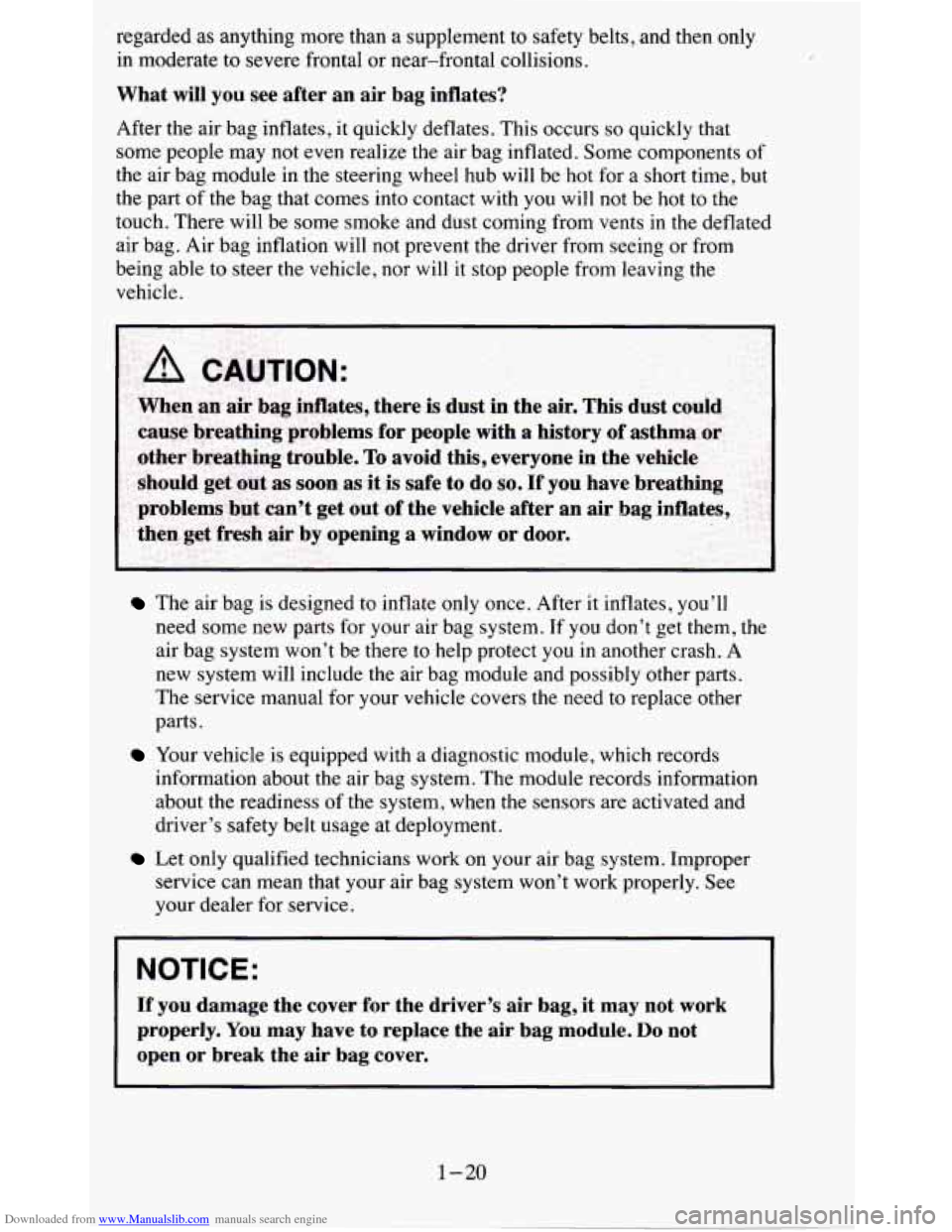
Downloaded from www.Manualslib.com manuals search engine regarded as anything more than a supplement to safety belts, and then only\
in moderate to severe frontal or near-frontal collisions.
What will you see after an air bag inflates?
After the air bag inflates, it quickly deflates. This occurs so quickly that
some people may not even realize the air bag inflated. Some compone\
nts of
the air bag module in the steering wheel hub will be hot for a short\
time, but
the part
of the bag that comes into contact with you will not be hot to the
touch. There will be some smoke and dust coming from vents in the deflated
air bag. Air bag inflation will not prevent the driver from seeing\
or from
being able to steer the vehicle, nor will it stop people from leaving
the
vehicle.
The air bag is designed to inflate only once. After it inflates, you’ll
need some new parts for your air bag system. If you don’t get them, the
air bag system won’t be there to help protect
you in another crash. A
new system will include the air bag module and possibly other parts.
The service manual for your vehicle covers the need
to replace other
parts.
information about the air bag system. The module records information
about the readiness of the system, when the sensors are activated and
driver’s safety belt usage at deployment.
Your vehicle is equipped with a diagnostic module, which records
Let only qualified technicians work on your air bag system. Improper
service can mean that your air bag system won’t work properly.
See
your dealer for service.
NOTICE:
If you damage the cover for the driver’s air bag, it may not work
properly. You may have to replace the air bag module. Do not
open or break the air bag cover.
1-20
Page 31 of 380
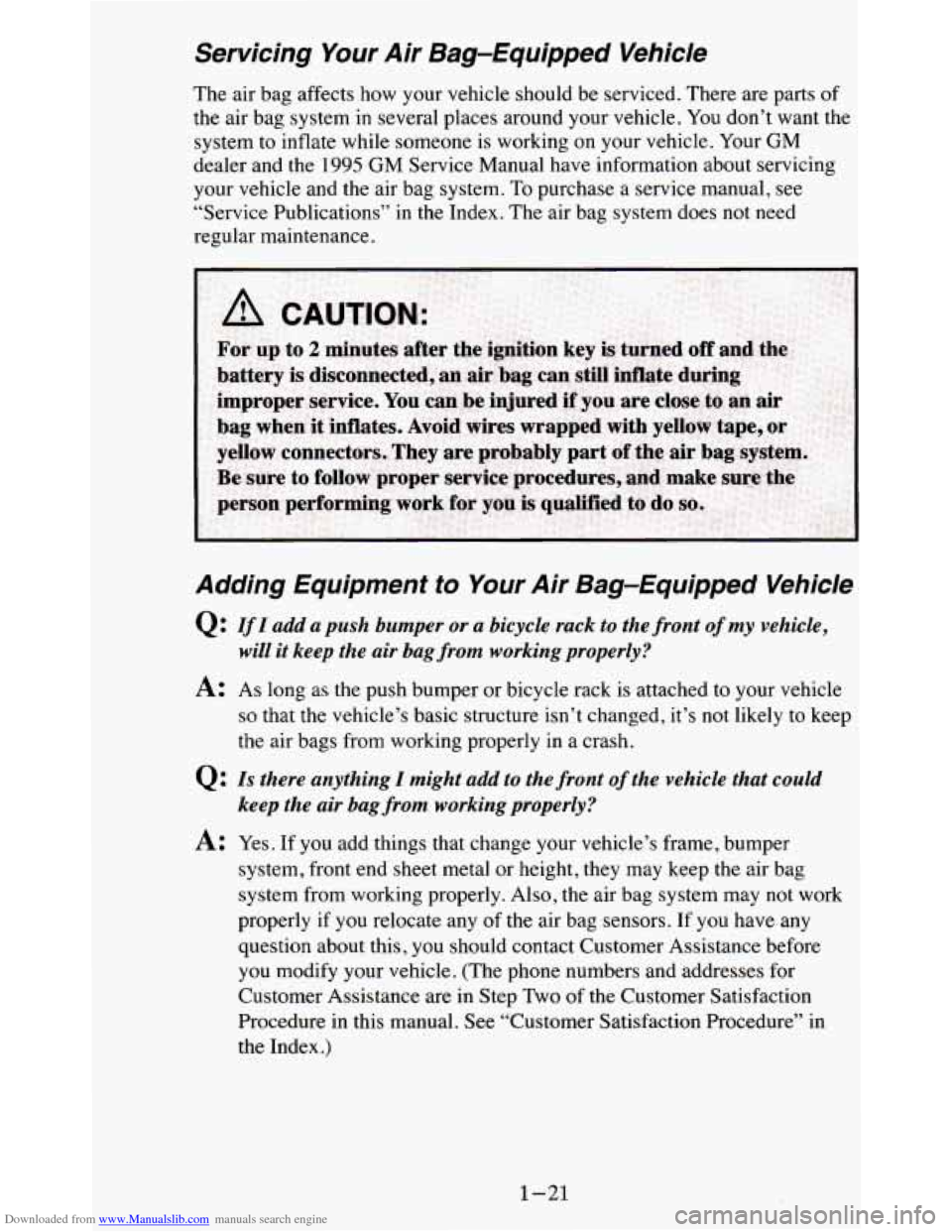
Downloaded from www.Manualslib.com manuals search engine Servicing Your Air Bag-Equipped Vehicle
The air bag affects how your vehicle should be serviced. There are parts of
the air bag system
in several places around your vehicle. You don’t want the
system to inflate
while someone is working on your vehicle. Your GM
dealer and the 1995 GM Service Manual have information about servicing
your vehicle and the air bag system.
To purchase a service manual, see
“Service Publications”
in the Index. The air bag system does not need
regular maintenance.
Adding Equipment to Your Air Bag-Equipped Vehicle
Q : If I add a push bumper or a bicycle rack to the front of my vehicle,
A: As long as the push bumper or bicycle rack is attached to your vehicle
will it keep the air bag from working properly?
so that the vehicle’s basic structure isn’t changed, it’s not likely to keep
the air bags from working properly
in a crash.
0: Is there anything I might add to the front of the vehicle that could
keep
the air bag from working properly?
A: Yes. If you add things that change your vehicle’s frame, bumper
system, front end sheet metal or height,
they may keep the air bag
system from working properly. Also, the air bag system may not work
properly if
you relocate any of the air bag sensors. If you have any
question about this, you should contact Customer Assistance before
you modify your vehicle. (The phone numbers and addresses for
Customer Assistance are
in Step Two of the Customer Satisfaction
Procedure in this manual. See “Customer Satisfaction Procedure” in
the Index
.)
1-21
Page 121 of 380
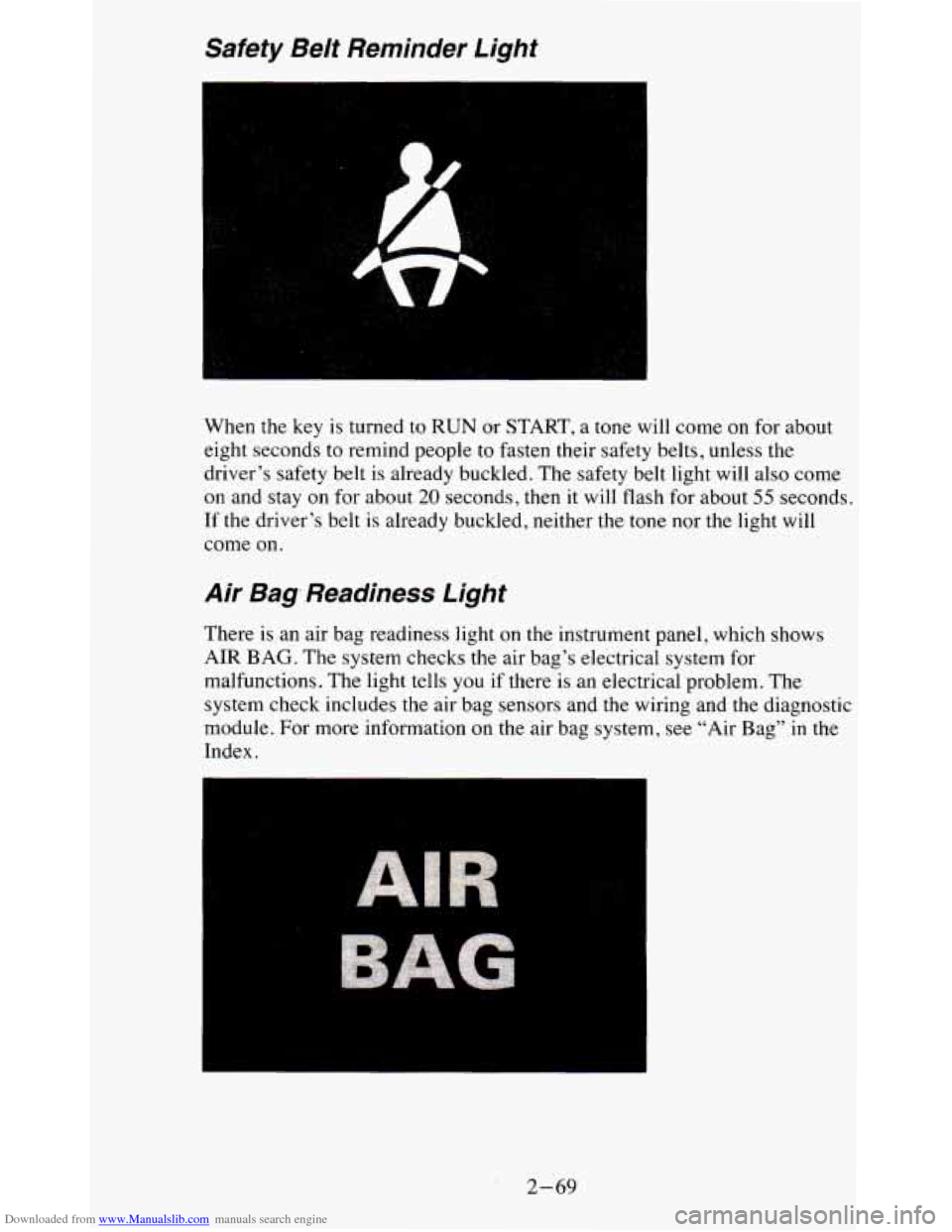
Downloaded from www.Manualslib.com manuals search engine Safety Be/t Reminder Light
When the key is turned to RUN or START, a tone will come on for about
eight seconds to remind people to fasten their safety belts, u\
nless the
driver’s safety belt is already buckled. The safety belt light
will also come
on and stay on for about
20 seconds, then it will flash for about 55 seconds.
If the driver’s belt
is already buckled, neither the tone nor the light will
come on.
Air Bag, Readiness Light
There is an air bag readiness light on the instrument panel, which shows
AIR BAG. The system checks the air bag’s electrical system for
malfunctions. The light tells you
if there is an electrical problem. The
system check includes the air bag sensors and
the wiring and the diagnostic
module. For more information on the air bag system, see “Air Bag”
in the
Index.
2-69
Page 244 of 380
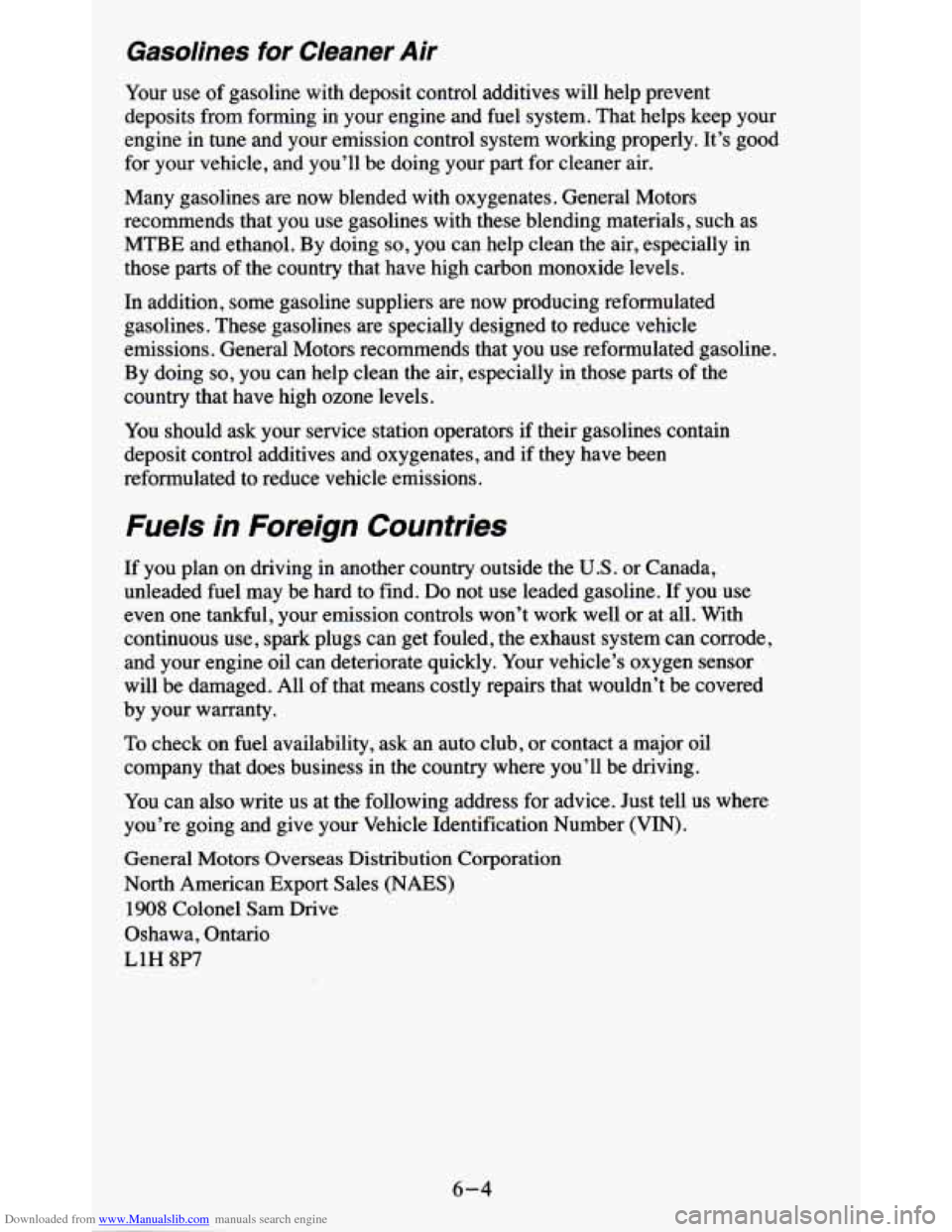
Downloaded from www.Manualslib.com manuals search engine Gasolines for Cleaner Air
Your use of gasoline with deposit control additives will help preven\
t
deposits from forming in your engine and fuel system. That hel\
ps keep your
engine
in tune and your emission control system working properly. It’s \
good
for your vehicle, and you’ll be doing your part for cleaner air.
Many gasolines are now blended with oxygenates. General Motors
recommends that you use gasolines with these blending materials, such as
MTBE and ethanol. By doing so, you can help clean the air, especially in
those parts of the country that have high carbon monoxide levels.
In addition, some gasoline suppliers are now producing reformulated
gasolines. These gasolines are specially designed to reduce vehicle
emissions. General Motors recommends that you use reformulated gasoline.
By doing
so, you can help clean the air, especially in those parts of the
country that have high ozone levels.
You should ask your service station operators if their gasolines contain
deposit control additives and oxygenates, and
if they have been
reformulated
to reduce vehicle emissions.
Fuels in Foreign Countries
If you plan on driving in another country outside the U.S. or Canada,
unleaded fuel may be hard to find.
Do not use leaded gasoline. If you use
even one tankful, your emission controls won’t work well or at all. With
continuous use, spark plugs can get fouled, the exhaust system can corrode,
and your engine oil can deteriorate quickly. Your vehicle’s oxygen sensor
will be damaged. All of that means costly repairs that wouldn’t be covered
by your warranty.
To check on fuel availability, ask an auto club, or contact a major oil
company that does business in the country where you’ll be driving.
You can also write us at the following address for advice. Just tell us where
you’re going and give your Vehicle Identification Number (VI\
N).
General Motors Overseas Distribution Corporation
North American Export Sales (NAES)
1908 Colonel Sam Drive
Oshawa, Ontario
L1H 8P7
6-4
Page 280 of 380
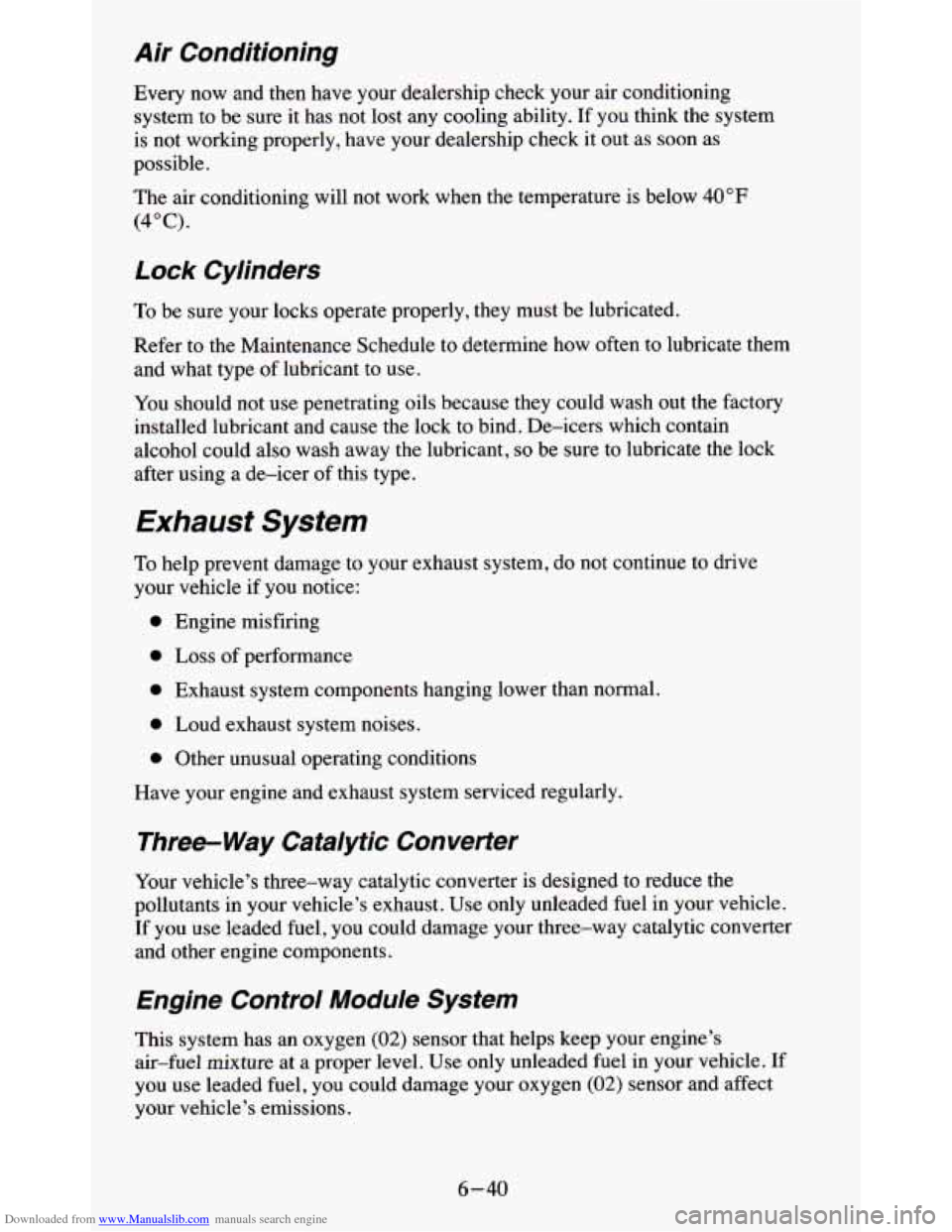
Downloaded from www.Manualslib.com manuals search engine Air Conditioning
Every now and then have your dealership check your air conditioning
system to be sure it has not lost any cooling ability. If you think\
the system
is not working properly, have your dealership check it out as \
soon as
possible.
The air conditioning will not work when the temperature is below
40°F
(4°C).
Lock Cylinders
To be sure your locks operate properly, they must be lubricated.
Refer to the Maintenance Schedule to determine how often to lubricate them
and what type
of lubricant to use.
You should not
use penetrating oils because they could wash out me factory
installed lubricant and cause the lock to bind. De-icers which \
contain
alcohol could also wash away the lubricant,
so be sure to lubricate the lock
after using a de-icer of this type.
Exhaust System
To help prevent damage to your exhaust system, do not continue to drive
your vehicle
if you notice:
0 Engine misfiring
0 Loss of performance
0 Exhaust system components hanging lower than normal.
0 Loud exhaust system noises.
0 Other unusual operating conditions
Have your engine and exhaust system serviced regularly.
Three-way Catalytic Converter
Your vehicle’s three-way catalytic converter is designed to reduce \
the
pollutants in your vehicle’s exhaust. Use only unleaded fuel in your vehicle.
If you use leaded fuel, you could damage your three-way catalytic converter
and other engine components.
Engine Control Module System
This system has an oxygen (02) sensor that helps keep your engine’s
air-fuel mixture at a proper level. Use only unleaded fuel
in your vehicle. If
you use leaded fuel, you could damage your oxygen (02) sensor and affect
your vehicle’s emissions.
6-40
Page 308 of 380
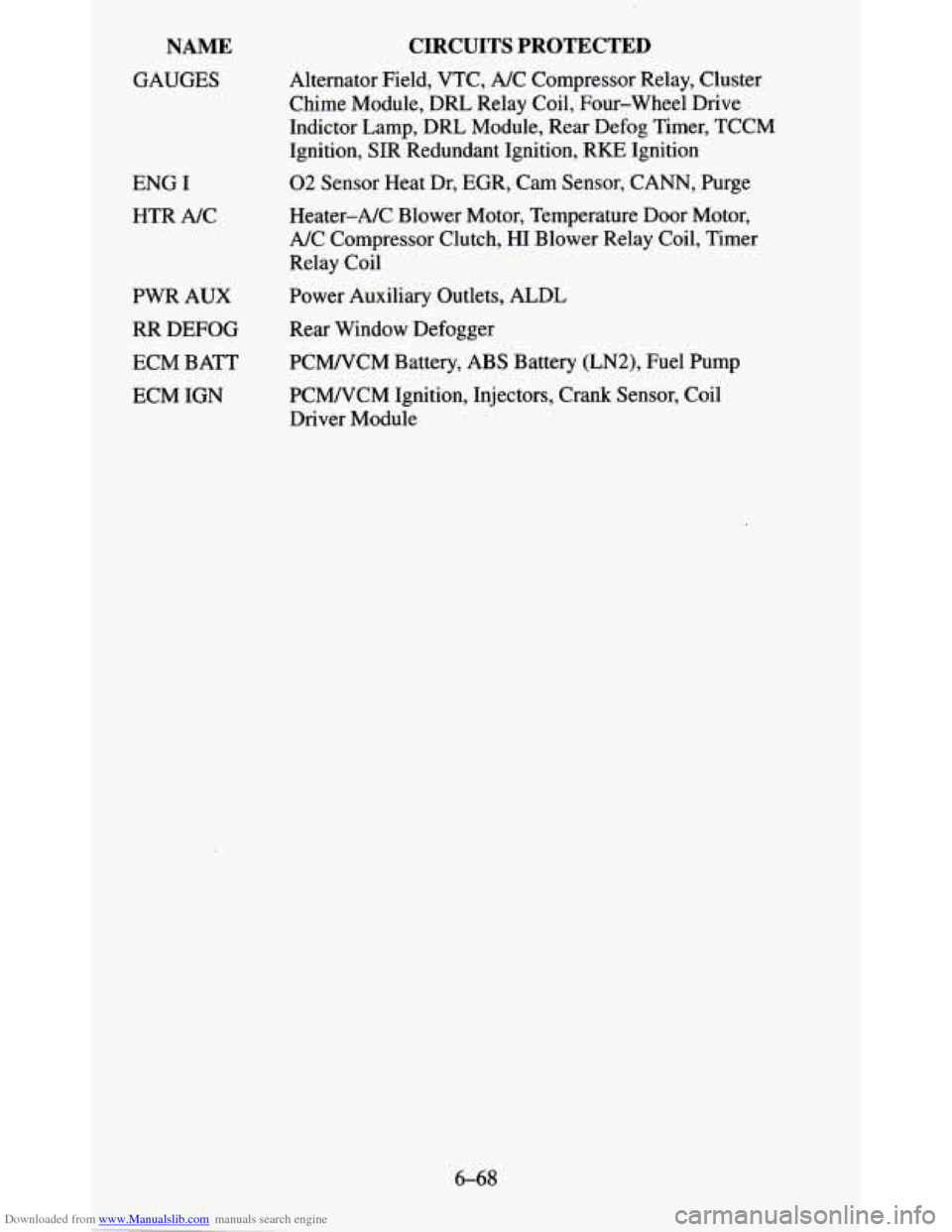
Downloaded from www.Manualslib.com manuals search engine NAME
GAUGES
ENG I HTR NC
PWR AUX
RR DEFOG
ECM BATT
ECM IGN
CIRCUITS PROTECTED
Alternator Field, VTC, A/C Compressor Relay, Cluster
Chime Module, DRL Relay Coil, Four-wheel Drive
Indictor Lamp, DRL Module, Rear Defog Timer, TCCM
Ignition,
SIR Redundant Ignition, RKE Ignition
02 Sensor Heat Dr, EGR, Cam Sensor, CANN, Purge
Heater-A/C Blower Motor, Temperature Door Motor,
A/C Compressor Clutch, HI Blower Relay Coil, Timer
Relay Coil
Power Auxiliary Outlets, ALDL
Rear Window Defogger
PCMNCM Battery, ABS Battery (LN2), Fuel Pump
PCMNCM Ignition, Injectors, Crank Sensor, Coil
Driver Module
6-68